72nd Shankaracharya ascends the throne of Kudali Sringeri Maha-samsthan
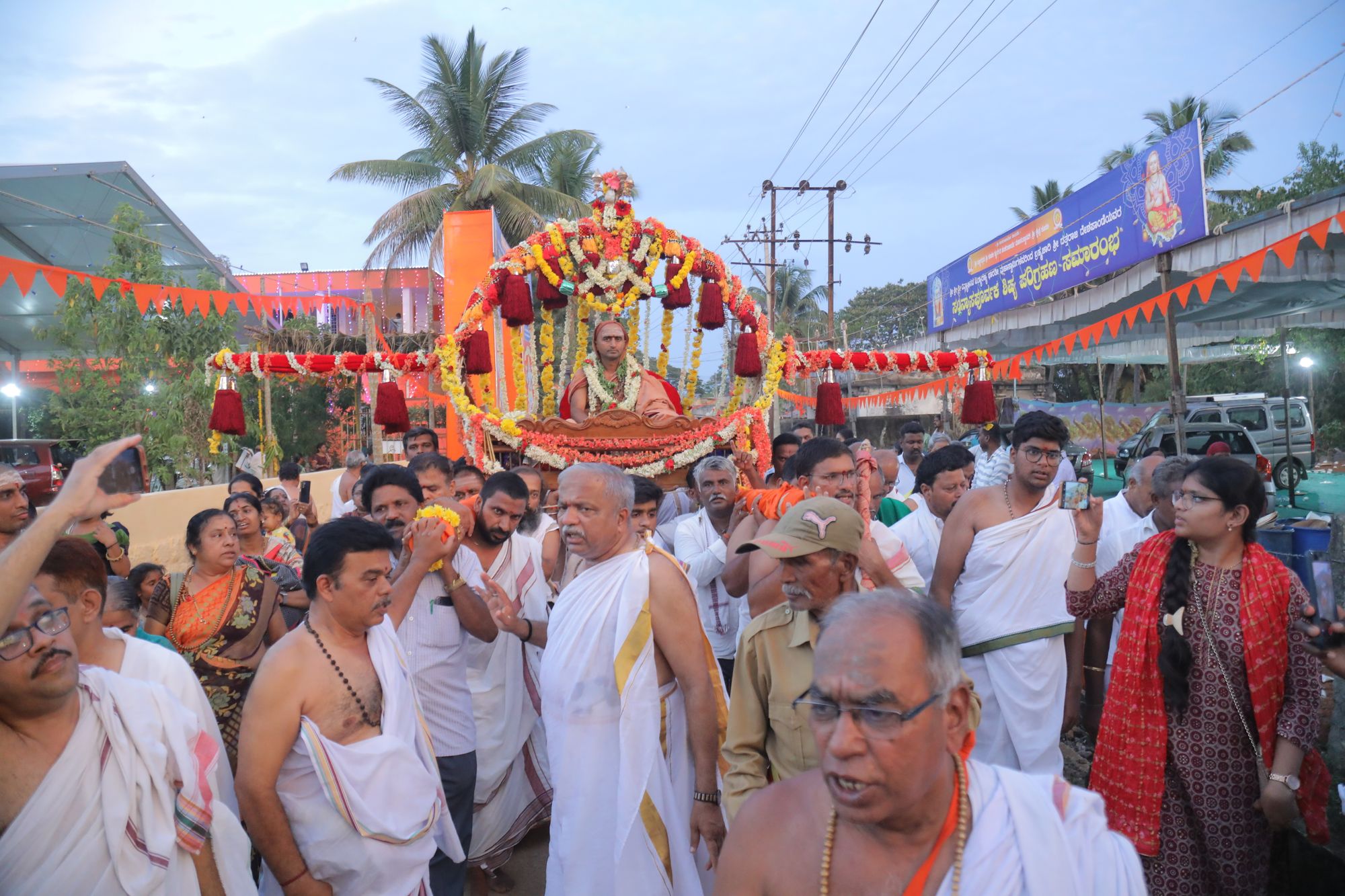
Kudali Sringeri Samsthan is an important institution of the Bharatiya civilization, established by Adi Shankaracharya around 2500 years ago at Kudali (confluence of Tunga and Bhadra rivers) in Karnataka state. Therefore, it is called Sri ‘Jagadguru Shankaracharya Samsthan’ or ‘Dakshinamnaya Sharada Peetha’ and is commonly referred to as Kudali Sringeri mutt locally.
At Kudali, the enchanting union of the Tunga and Bhadra rivers creates a picturesque confluence, surrounded by ancient tirthas and temples. This sacred place, located in present-day Shimoga district of Karnataka, is often referred to as the Varanasi of the South. One unique aspect of Kudali is the standing posture in which Devi Sharadamba is worshipped, a representation that is exclusive to this location
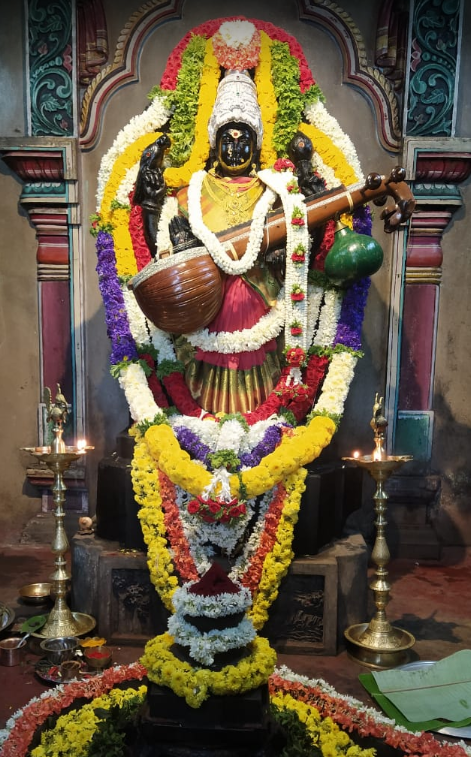
There is an intriguing tale behind the unique posture of Devi Sharadamba. Ubhaya Bharati, the righteous and learned wife of Mandana Misra, played a significant role as the judge in the renowned debate on philosophical intricacies between Mandana Misra and Shankaracharya. During the debate, both participants wore garlands of flowers, and the one whose garland withered would be deemed the loser. After a lengthy discourse, Mandana Misra's garland faded away, symbolizing his defeat, while Shankaracharya's garland remained fresh. Therefore, Ubhaya Bharati proclaimed Shankaracharya as the victor, and in accordance with the agreed-upon terms, Mandana Misra became a devoted disciple of Acharya Shankara. Recognizing Ubhaya Bharati as the earthly embodiment of Saraswati, the goddess of knowledge, Shankaracharya requested her to accompany him towards the south. She consented on the condition that she would remain wherever he stopped to look back at her.
As Shankaracharya journeyed southward, he arrived at a place renowned as the ashrama of the illustrious Rishyasringa. Mesmerized by the celestial charm of the confluence of the Tunga and Bhadra rivers, he recognized it as the ideal location. Turning back at that very moment, he found Devi Sharadamba standing there. Shankaracharya offered his worship and established a temple dedicated to her, depicting her in the standing posture. He composed the Sharada Bhujanga stotram, a hymn that eloquently praises her maternal benevolence and divine grace –
कटाक्षे दयार्द्रां करे ज्ञानमुद्रां
कलाभिर्विनिद्रां कलापैः सुभद्राम्।
पुरस्त्रीं विनिद्रां पुरस्तुङ्गभद्रां
भजे शारदाम्बामजस्रं मदम्बाम्॥
Which means –
She is the one with tear-filled eyes, emanating compassion. She gracefully holds the Jnaana-mudra, having flourished in various arts and knowledge systems (kalaa), adorned with exquisite ornaments. She embodies nobility and radiates constant brilliance. As the river Tungabhadra flows serenely before her, I offer my heartfelt prayers to Sharadamba, my revered Mother.
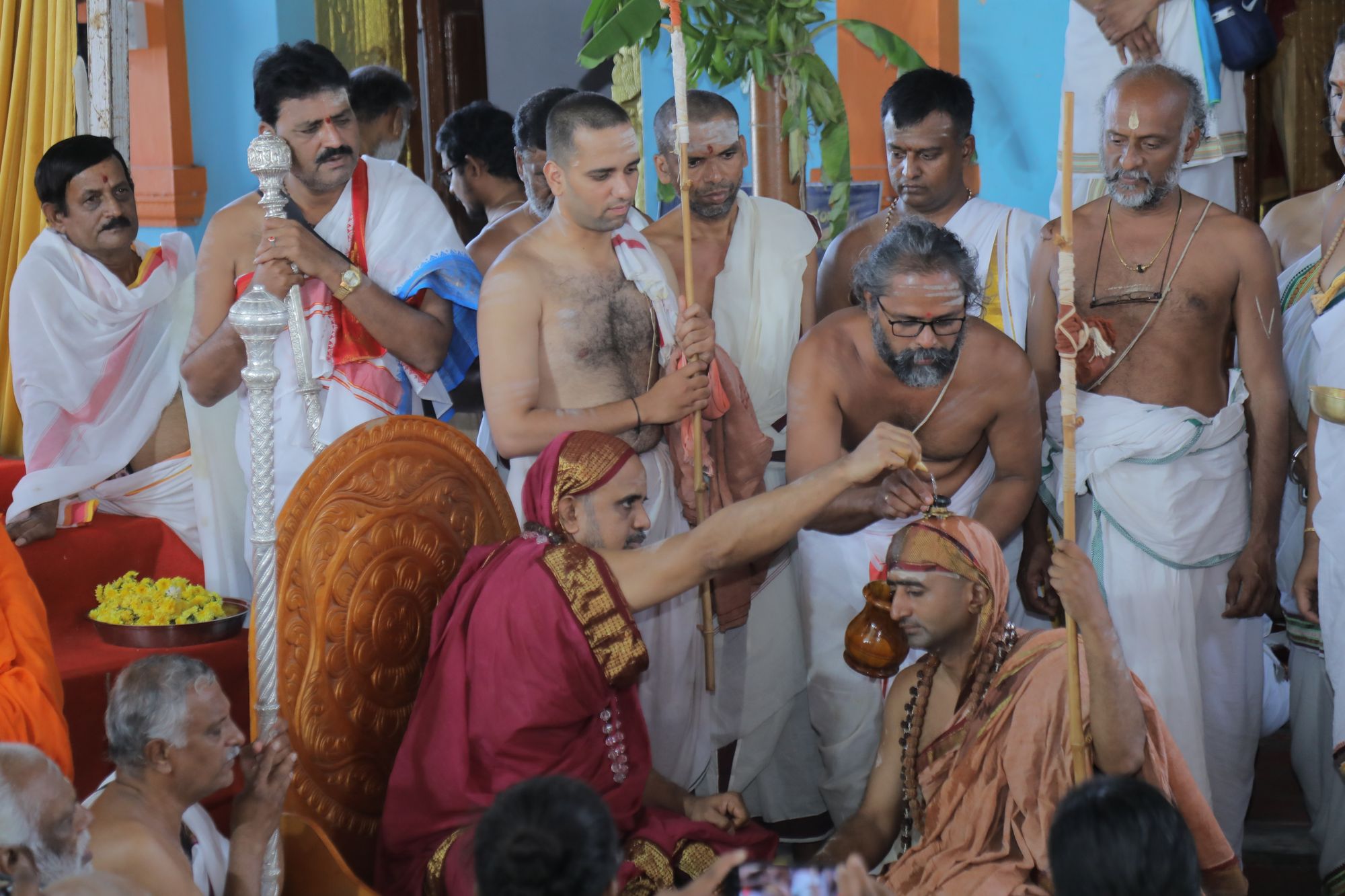
Afterward, Shankaracharya established the Dakshinamnaya Sharada Peetham and appointed Mandana Misra, who was bestowed the name Sureshwaracharya, as its Peethadhipati. Over the course of 2500 years, this sacred institution, guided by erudite and spiritually evolved Acharyas, has been disseminating the eternal philosophy of Advaita. Kudali Sringeri Sharada Peetham is one among the four establishments initiated by Shankaracharya, aimed at upholding the Vedas and Shastras, which provide invaluable principles to guide individuals in discovering the most meaningful pursuits in life.
In a continuation of the revered tradition spanning 2500 years, His Holiness Sri Sri Vidyabhinava Vidyaranya Bharati Mahaswami, the 71st Peetadhipathi, appointed Sri Abhinava Shankara Bharati Swami as his successor of the Mahasamstanam on 22nd May 2023. The auspicious ceremony, spanning five days and commencing on 18th May, witnessed the gracious presence of numerous Gurus and Mathadhipatis who had gathered in Kudali. During this sacred event, Mahaswami bestowed Sanyasa Deeksha upon the next-in-line, imparted Mahavakya Upadesha, and bestowed upon him a new name. The ceremony concluded with the solemn Pethaarohanam and Pattabhishekam rituals. Notably, His Holiness Sri Vijayendra Saraswati, the Mahaswamy of Kanchi Kamakoti Peetham, conveyed his greetings to the new Peethadhipati through a live video conference, adding to the joyous occasion. Thousands of devotees flocked to witness this momentous event, filled with divine grace and significance.
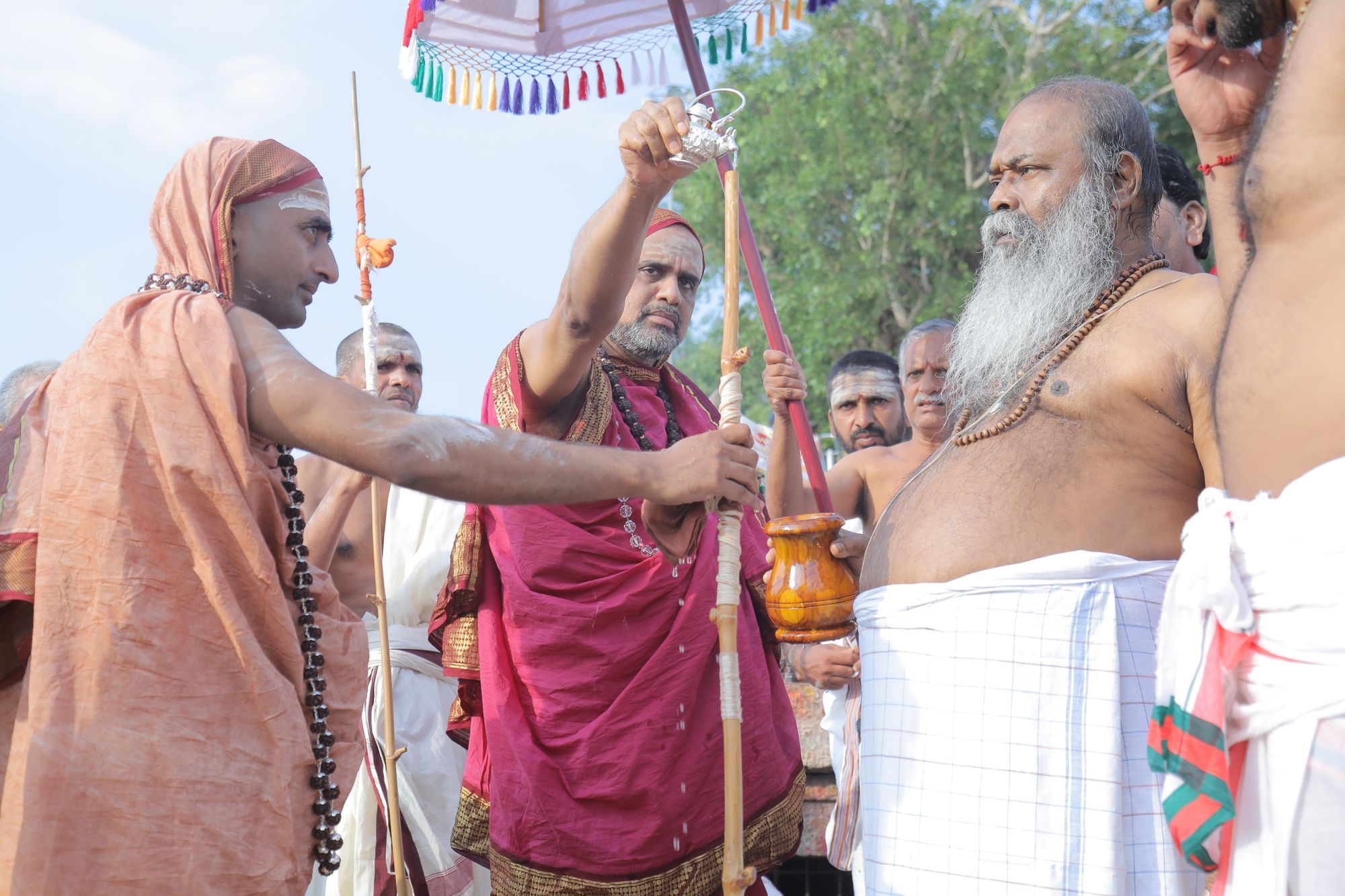
Background of New Shankaracharya:
Hailing from a traditional family in North Karnataka, the 72nd Shankaracharya, formerly known as Dattaraj Deshpande, has been deeply immersed in the realms of Vedic knowledge. His journey as a scholar began in the time-honored Gurukul system, where he imbibed the wisdom of the ancient scriptures through the oral tradition. As a dedicated researcher, author, and documentary filmmaker, he has delved into the depths of Vedic wisdom, unearthing its profound insights. In his formative years, rather than pursuing formal education in conventional schools, he embarked on a remarkable quest across South India. Taking residence in the homes of revered Vedic scholars, he became their devoted disciple and immersed himself in the study of the Rigveda.
The Vedas are divided into three sections known as Samhita, Brahmana, and Aranyaka. Each Veda comprises these three Kaandas. Additionally, the Vedas are further enriched by six auxiliary disciplines known as Shiksha, Vyakarana, Chhandas, Nirukta, Jyotish, and Kalpa. These six limbs of the Vedas enhance and elucidate their profound teachings. In the Indigenous education system, an individual who possesses deep knowledge of these nine texts, along with the Praati-shaakhya, is revered as a "Dasha-granthi" or a master of ten scriptures. Dattaraj Deshpande was one such erudite scholar who excelled in all these areas. As his journey unfolded, he developed a keen interest in Dharma Shastra and Indology, further expanding his scholarly pursuits.
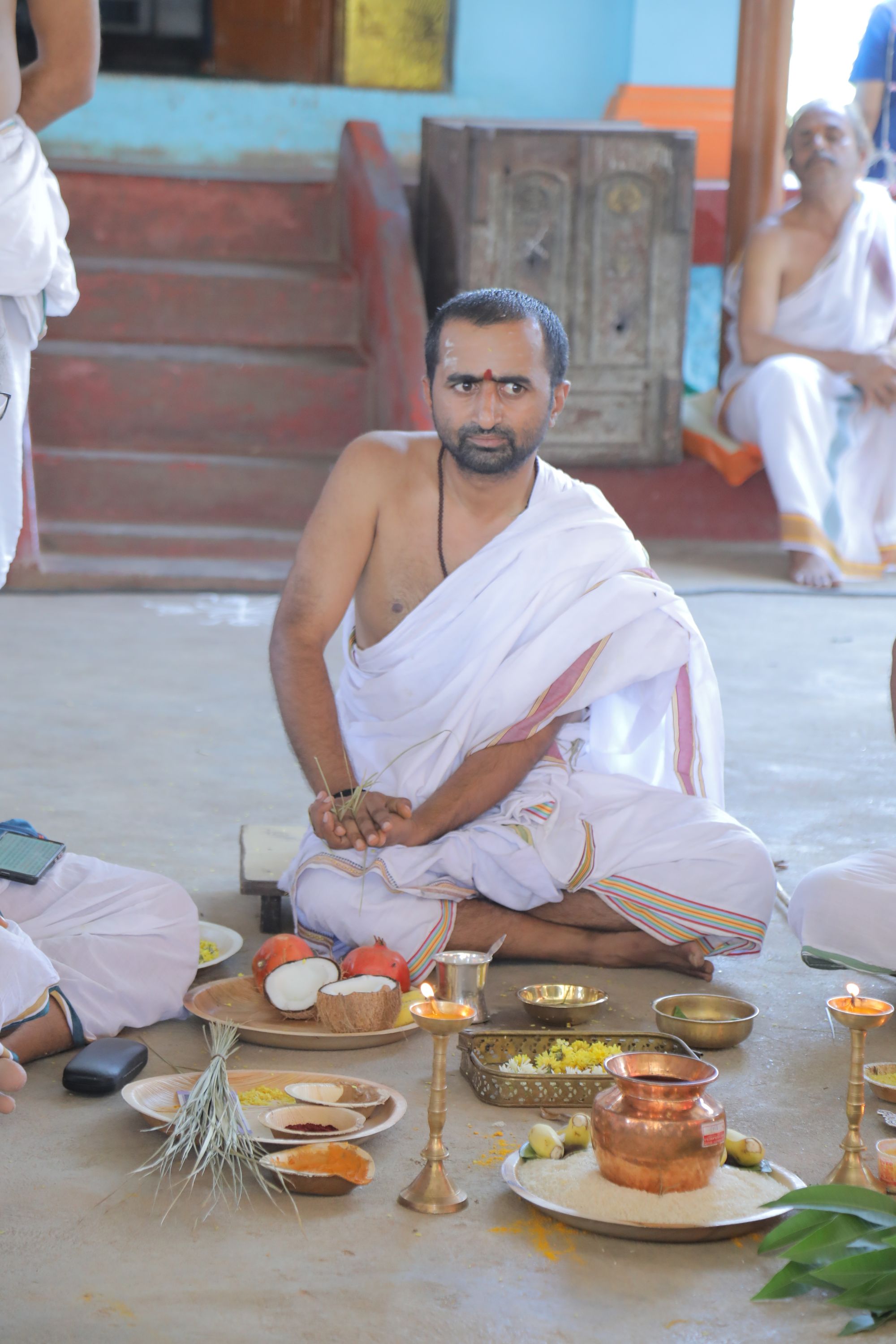
At a young age of 17, his first book was published, marking the beginning of his illustrious literary career. Since then, he has relentlessly pursued his passion for research and writing, penning insightful columns and publishing books. In addition to his literary contributions, he has ventured into the realm of documentary filmmaking, using this powerful medium to convey profound messages. Alongside his creative endeavors, he dedicated himself to the role of a Vedic teacher, study of Yajurveda and Samaveda while actively engaging in the noble task of imparting Vedic knowledge to others.
In the year 2018, Dattaraj Deshpande took a momentous decision to renounce his career and leave behind his familial responsibilities. Driven by a deep sense of purpose, he devoted himself as a full-time volunteer at Bharatiya Shikshan Mandal (BSM), an organization dedicated to the revival of the Gurukul Education System. Within BSM, he held the esteemed position of State Organizing Secretary of Tamil Nadu, shouldering important responsibilities and contributing significantly to the organization's noble cause. However, destiny had a greater calling for him. Recognizing his immense potential and his unwavering commitment to upholding the ancient traditions, he was chosen to assume his present role at Kudali, where he now stands as a torchbearer of the peetham and its glorious 2500-year-old parampara.
Significance of Samsthan
Until the year 1960, Kudali Sringeri Samsthan enjoyed a reputation as the most prosperous institution, owing to the generous support of kings, local chiefs, and devoted followers. Notable personalities, including the esteemed Maharaja of Mysore and the former President of Bharata, Dr. S Radhakrishnan, sought the guidance and counsel of the revered Kudali Mahaswami Sri Satchidananda Shankra Bharathi, on matters of governance and administration. The Maharaja of Mysore, in particular, held Swamiji in high regard and regularly hosted him in Mysore. It was during these interactions that the Maharaja had the privilege of studying Artha Shastra under the profound tutelage of Swamiji.
According to historical records and accounts from British surveys, the influence of the mutt is well-documented. In Sir Francis Buchanan's book, "A Journey from Madras through the Countries of Mysore, Canara, and Malabar" (1807), he provides insights into the mutt's remarkable humanitarian efforts. During a severe famine, the mutt organized and provided food for thousands of people, showcasing their compassionate service to those in need. This event stands as a testament to the mutt's dedication and commitment to alleviating suffering and extending support to the affected communities.
How to reach Kudali ?
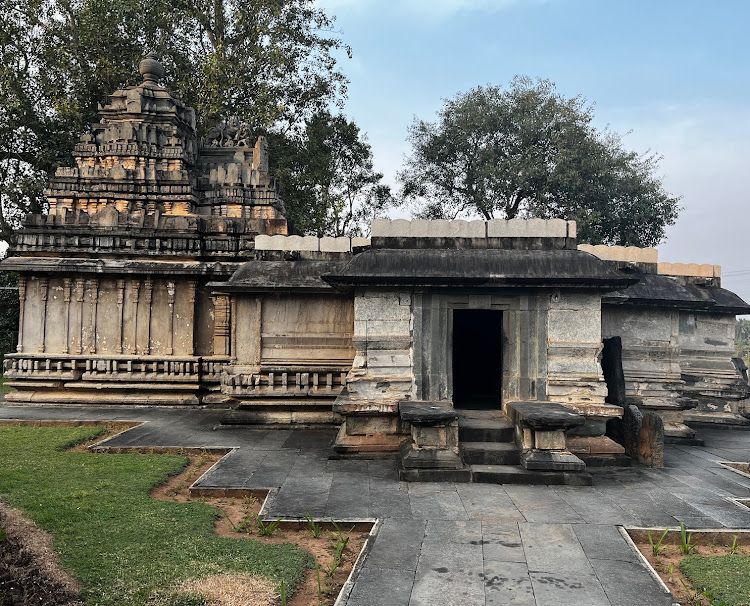
Devotees who arrive at Kudali find natural joy and bliss.
The mutt is around 16 km from Shimoga, which is the district headquarters. Shimoga, located about 300 km from Bengaluru, has a new airport and good rail and highway connections.
Contact details:
Srimad Jagadguru Sri Kudali Sringeri Shankaracharya MahasamsthanamDakshinamnaya Sri Sarada Peetham,
Kudali, Shimoga District, Karnataka
India - 577 237
Phone: 9731731154

